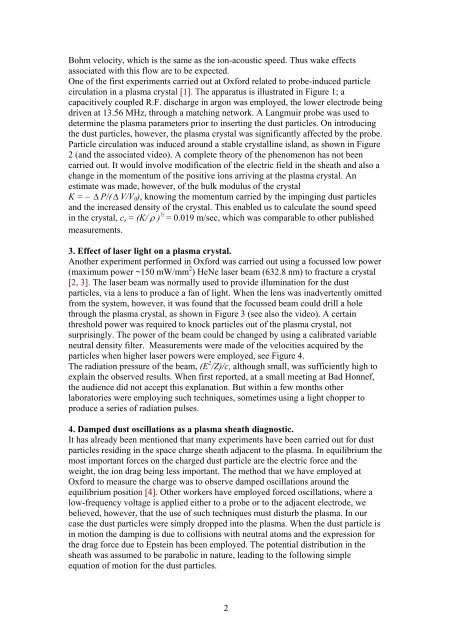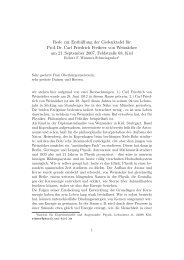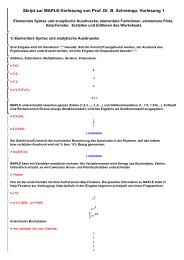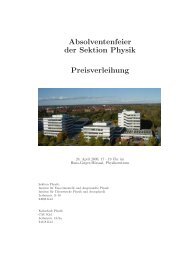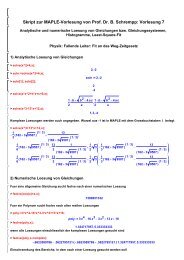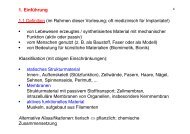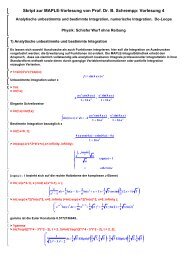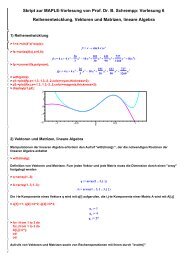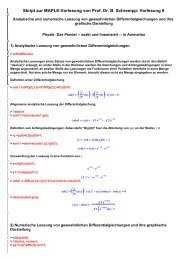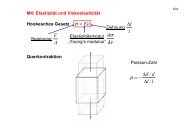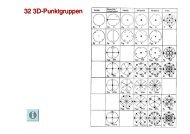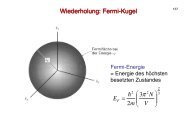Some Researches on Dusty Plasmas
Some Researches on Dusty Plasmas
Some Researches on Dusty Plasmas
You also want an ePaper? Increase the reach of your titles
YUMPU automatically turns print PDFs into web optimized ePapers that Google loves.
Bohm velocity, which is the same as the i<strong>on</strong>-acoustic speed. Thus wake effects<br />
associated with this flow are to be expected.<br />
One of the first experiments carried out at Oxford related to probe-induced particle<br />
circulati<strong>on</strong> in a plasma crystal [1]. The apparatus is illustrated in Figure 1; a<br />
capacitively coupled R.F. discharge in arg<strong>on</strong> was employed, the lower electrode being<br />
driven at 13.56 MHz, through a matching network. A Langmuir probe was used to<br />
determine the plasma parameters prior to inserting the dust particles. On introducing<br />
the dust particles, however, the plasma crystal was significantly affected by the probe.<br />
Particle circulati<strong>on</strong> was induced around a stable crystalline island, as shown in Figure<br />
2 (and the associated video). A complete theory of the phenomen<strong>on</strong> has not been<br />
carried out. It would involve modificati<strong>on</strong> of the electric field in the sheath and also a<br />
change in the momentum of the positive i<strong>on</strong>s arriving at the plasma crystal. An<br />
estimate was made, however, of the bulk modulus of the crystal<br />
K = – Δ P/( Δ V/V 0 ), knowing the momentum carried by the impinging dust particles<br />
and the increased density of the crystal. This enabled us to calculate the sound speed<br />
in the crystal, c s = (K/ ρ ) ½ = 0.019 m/sec, which was comparable to other published<br />
measurements.<br />
3. Effect of laser light <strong>on</strong> a plasma crystal.<br />
Another experiment performed in Oxford was carried out using a focussed low power<br />
(maximum power ~150 mW/mm 2 ) HeNe laser beam (632.8 nm) to fracture a crystal<br />
[2, 3]. The laser beam was normally used to provide illuminati<strong>on</strong> for the dust<br />
particles, via a lens to produce a fan of light. When the lens was inadvertently omitted<br />
from the system, however, it was found that the focussed beam could drill a hole<br />
through the plasma crystal, as shown in Figure 3 (see also the video). A certain<br />
threshold power was required to knock particles out of the plasma crystal, not<br />
surprisingly. The power of the beam could be changed by using a calibrated variable<br />
neutral density filter. Measurements were made of the velocities acquired by the<br />
particles when higher laser powers were employed, see Figure 4.<br />
The radiati<strong>on</strong> pressure of the beam, (E 2 /Z)/c, although small, was sufficiently high to<br />
explain the observed results. When first reported, at a small meeting at Bad H<strong>on</strong>nef,<br />
the audience did not accept this explanati<strong>on</strong>. But within a few m<strong>on</strong>ths other<br />
laboratories were employing such techniques, sometimes using a light chopper to<br />
produce a series of radiati<strong>on</strong> pulses.<br />
4. Damped dust oscillati<strong>on</strong>s as a plasma sheath diagnostic.<br />
It has already been menti<strong>on</strong>ed that many experiments have been carried out for dust<br />
particles residing in the space charge sheath adjacent to the plasma. In equilibrium the<br />
most important forces <strong>on</strong> the charged dust particle are the electric force and the<br />
weight, the i<strong>on</strong> drag being less important. The method that we have employed at<br />
Oxford to measure the charge was to observe damped oscillati<strong>on</strong>s around the<br />
equilibrium positi<strong>on</strong> [4]. Other workers have employed forced oscillati<strong>on</strong>s, where a<br />
low-frequency voltage is applied either to a probe or to the adjacent electrode, we<br />
believed, however, that the use of such techniques must disturb the plasma. In our<br />
case the dust particles were simply dropped into the plasma. When the dust particle is<br />
in moti<strong>on</strong> the damping is due to collisi<strong>on</strong>s with neutral atoms and the expressi<strong>on</strong> for<br />
the drag force due to Epstein has been employed. The potential distributi<strong>on</strong> in the<br />
sheath was assumed to be parabolic in nature, leading to the following simple<br />
equati<strong>on</strong> of moti<strong>on</strong> for the dust particles.<br />
2


